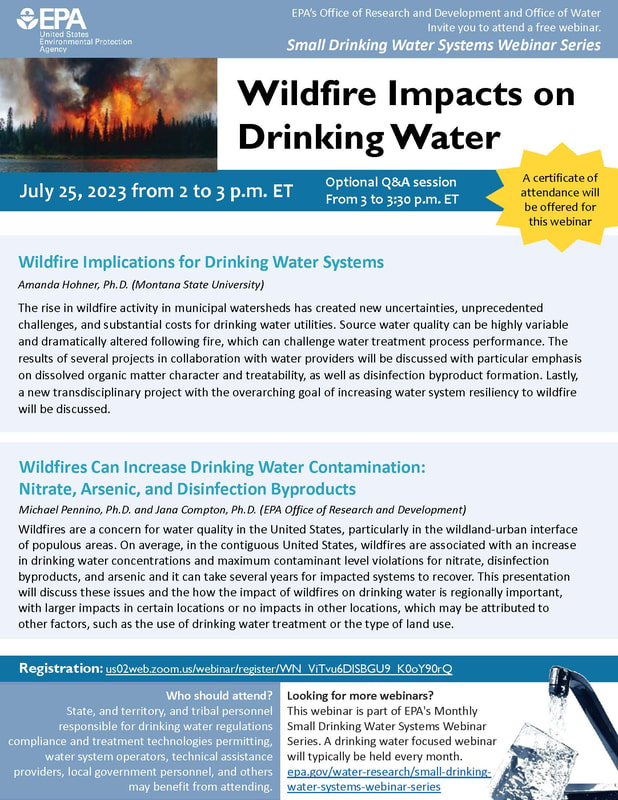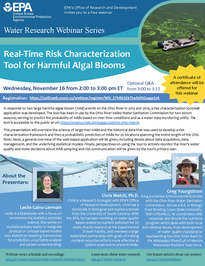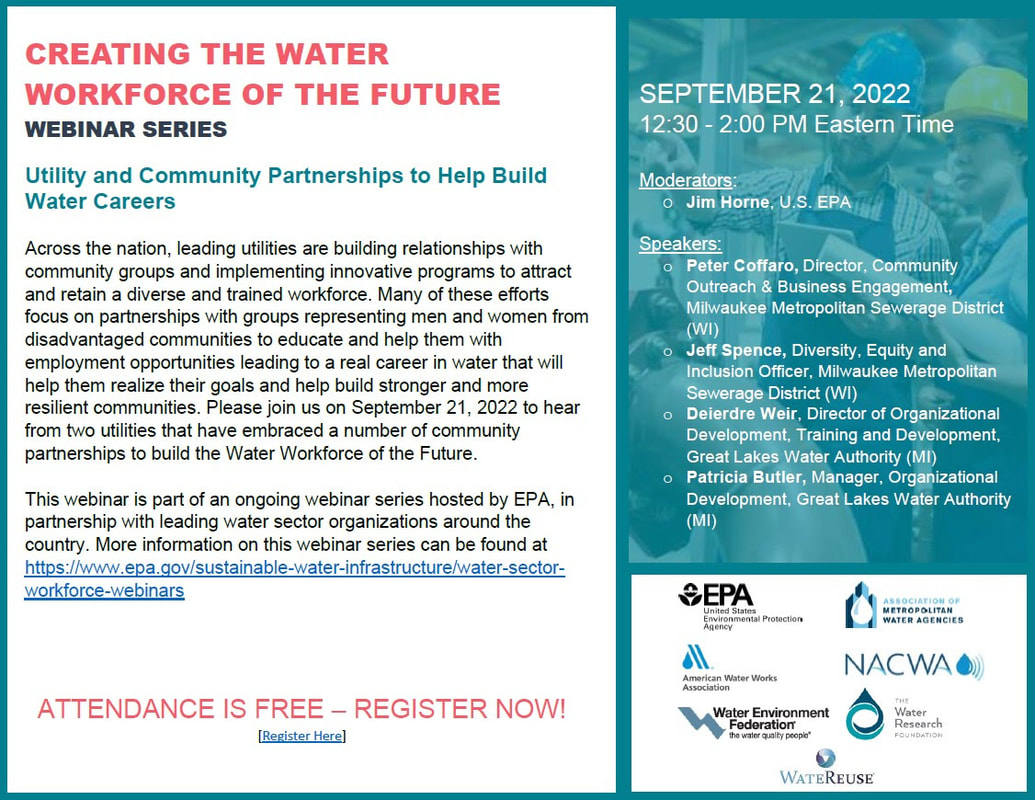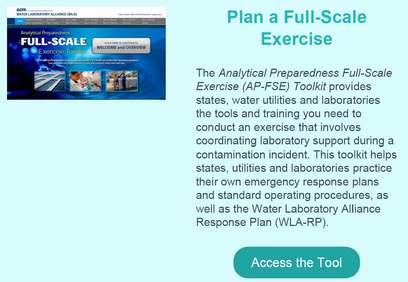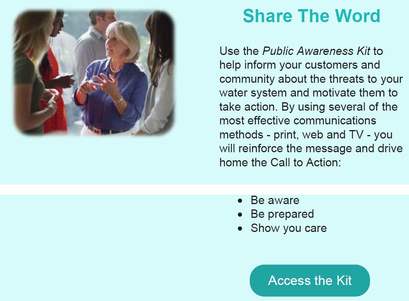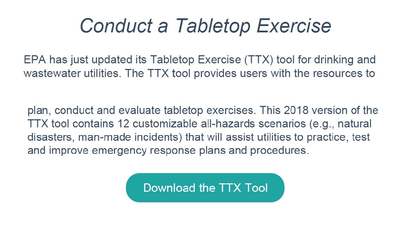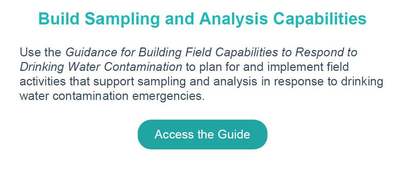Click here for EPA Drinking Water Rule Quick Reference Guides
Click here for Online Water / Wastewater Webinars
Click here for Online Water / Wastewater Webinars
2023 EPA Resources
Posted July 07, 2023- July 25, 2023 EPA webinar 8:00 am HST
Click here or on images below to register for the upcoming webinar.
Click here or on images below to register for the upcoming webinar.
| july_2023_small_systems_webinar_flyer.pdf |
On March 16, 2023, the following article was published by CNET regarding the new EPA standards on PFAS in drinking water.
"EPA Says It's Cleaning Up Our Tap Water. Here's What to Know About PFAS"
Read more...
"EPA Says It's Cleaning Up Our Tap Water. Here's What to Know About PFAS"
Read more...
EPA Tools & Resources Webinar
Wildland Fire Research to Protect Health and the Environment
Wednesday, March 15, 2023: 3-4 pm ET
The west and other parts of the US have experienced significant forest fires in recent years. These fires have been devastating to infrastructure, yet there is limited knowledge of the human health impacts of smoke emissions. EPA is using its expertise in air quality research to fill the gaps in scientific information and to develop tools to prevent and reduce the impact of smoke from wildfires and controlled or prescribed burns. This webinar will provide an update on Wildland Fire Research to Protect Health and the Environment. Research includes wildfire impacts on human health and ecosystems, a comparative assessment of air quality and public health impacts from prescribed fire and wildfire smoke, air sensors for smoke monitoring applications, an EPA air sensor loan program, resources on indoor air filtration during smoke events, and communication strategies to enhance local readiness for wildfires.
Register for the webinar: Wildland Fire Research to Protect Health and the Environment!
Wildland Fire Research to Protect Health and the Environment
Wednesday, March 15, 2023: 3-4 pm ET
The west and other parts of the US have experienced significant forest fires in recent years. These fires have been devastating to infrastructure, yet there is limited knowledge of the human health impacts of smoke emissions. EPA is using its expertise in air quality research to fill the gaps in scientific information and to develop tools to prevent and reduce the impact of smoke from wildfires and controlled or prescribed burns. This webinar will provide an update on Wildland Fire Research to Protect Health and the Environment. Research includes wildfire impacts on human health and ecosystems, a comparative assessment of air quality and public health impacts from prescribed fire and wildfire smoke, air sensors for smoke monitoring applications, an EPA air sensor loan program, resources on indoor air filtration during smoke events, and communication strategies to enhance local readiness for wildfires.
Register for the webinar: Wildland Fire Research to Protect Health and the Environment!
The following is the link to the press release from USEPA dated March 14, 2023 about the new PROPOSED drinking water standard for PFAS:
https://www.epa.gov/newsreleases/biden-harris-administration-proposes-first-ever-national-standard-protect-communities
The following is the link to USEPA's website about PFAS and the new proposed drinking water standard that was published. This link has a lot of information.
https://www.epa.gov/sdwa/and-polyfluoroalkyl-substances-pfas
Once the proposed standard is published in the Federal Register, the public has 60 days from the date of publication to comment on the proposed standard. USEPA plans to have the standard finalized by the end of 2023.
https://www.epa.gov/newsreleases/biden-harris-administration-proposes-first-ever-national-standard-protect-communities
The following is the link to USEPA's website about PFAS and the new proposed drinking water standard that was published. This link has a lot of information.
https://www.epa.gov/sdwa/and-polyfluoroalkyl-substances-pfas
Once the proposed standard is published in the Federal Register, the public has 60 days from the date of publication to comment on the proposed standard. USEPA plans to have the standard finalized by the end of 2023.
March 13, 2023-
“EPA Releases Memorandum on Cybersecurity in Public Water System Sanitary Surveys”
content.govdelivery.com/accounts/USEPAOGWDW/bulletins/34e711e
“EPA Releases Memorandum on Cybersecurity in Public Water System Sanitary Surveys”
content.govdelivery.com/accounts/USEPAOGWDW/bulletins/34e711e
| toolswebinar_flyer_wildfires.pdf |
EPA Tools & Resources Training Webinar
Climate Change Adaptation Resource Center (ARC-X)
Thursday, February 9, 2023: 3:00 to 4:00 pm ET
EPA’s Climate Change Adaptation Resource Center (ARC-X) is an innovative system designed to help all 40,000 communities across the US anticipate, prepare for, and adapt to the impacts of climate change. The ARC-X is unlike any other resource currently available to the public. Users are given an opportunity to first “self-identify” by indicating the region of the country in which they live and the specific issues of concern to them. The system then provides them with an integrated package of information tailored specifically to their needs, including insights on the implications of climate change for the issues they care about, case studies of how similar communities have successfully adapted, access to adaptation tools to replicate those successes, available training, and information on federal sources of funding. This webinar will provide an overview of ARC-X and how to use it.
Register for the Climate Change Adaption Resource Center (ARC-X) training webinar.
Climate Change Adaptation Resource Center (ARC-X)
Thursday, February 9, 2023: 3:00 to 4:00 pm ET
EPA’s Climate Change Adaptation Resource Center (ARC-X) is an innovative system designed to help all 40,000 communities across the US anticipate, prepare for, and adapt to the impacts of climate change. The ARC-X is unlike any other resource currently available to the public. Users are given an opportunity to first “self-identify” by indicating the region of the country in which they live and the specific issues of concern to them. The system then provides them with an integrated package of information tailored specifically to their needs, including insights on the implications of climate change for the issues they care about, case studies of how similar communities have successfully adapted, access to adaptation tools to replicate those successes, available training, and information on federal sources of funding. This webinar will provide an overview of ARC-X and how to use it.
Register for the Climate Change Adaption Resource Center (ARC-X) training webinar.
| trainingwebinar_flyer_arc-x.pdf |
EPA Tools & Resources Webinar
Data Mapping and Analyses to Identify US Locations with High Lead Exposures
Wednesday, February 15, 2023: 3:00 to 4:00 pm ET
The EPA Lead Strategy and the Federal Lead Action Plan highlight the need for a whole-of-government approach to map, identify, and address high lead exposure locations and disparities. EPA, the Department of Housing and Urban Development, and CDC recently co-authored a paper in the American Journal of Public Health on the state of the science and federal collaborations regarding lead data mapping. EPA is also developing, evaluating, and applying new mapping and data analysis approaches to help identify communities with high lead exposure risks and contributing sources and recently published an article in Environmental Health Perspectives, in collaboration with federal and state partners. Using Michigan as an initial case study, EPA applied innovative data analyses of available blood lead and other data at the census tract level to identify locations with high prevalence of children’s elevated blood lead levels. This work will help EPA continue to advance its data analysis and mapping science for lead so that states and communities have the information needed to target and prioritize actions to reduce, prevent, and mitigate lead exposure risk.
Register for the Data Mapping and Analyses to Identify US Locations with High Lead Exposures webinar.
Data Mapping and Analyses to Identify US Locations with High Lead Exposures
Wednesday, February 15, 2023: 3:00 to 4:00 pm ET
The EPA Lead Strategy and the Federal Lead Action Plan highlight the need for a whole-of-government approach to map, identify, and address high lead exposure locations and disparities. EPA, the Department of Housing and Urban Development, and CDC recently co-authored a paper in the American Journal of Public Health on the state of the science and federal collaborations regarding lead data mapping. EPA is also developing, evaluating, and applying new mapping and data analysis approaches to help identify communities with high lead exposure risks and contributing sources and recently published an article in Environmental Health Perspectives, in collaboration with federal and state partners. Using Michigan as an initial case study, EPA applied innovative data analyses of available blood lead and other data at the census tract level to identify locations with high prevalence of children’s elevated blood lead levels. This work will help EPA continue to advance its data analysis and mapping science for lead so that states and communities have the information needed to target and prioritize actions to reduce, prevent, and mitigate lead exposure risk.
Register for the Data Mapping and Analyses to Identify US Locations with High Lead Exposures webinar.
| toolswebinar_flyer_lead__002_.pdf |
January 19, 2023- This information is only for community and non-transient non-community water systems serving 3,300 and more to 10,000 people. You are required, for the first time since the Unregulated Contaminant Monitoring Rule (UCMR) program started in 1999, to conduct sampling for 30 contaminants under the Fifth UCMR (UCMR5). Sampling of your water system will take place from January 2023 to December 2025. Even though UCMR5 is implemented directly by the U.S. Environmental Protection Agency (USEPA), your contact for the sampling activities is the Great Lakes Environmental Center (GLEC), USEPA's contractor. GLEC will be working with the USEPA-approved analytical laboratories directly (there is an approved list of USEPA-approved labs under UCMR5) to coordinate the sampling activities for your water system. GLEC will package and ship sample kits to your water system approximately 7 to 10 days prior to the scheduled sampling date. The sample kits will have a pre-paid FedEx airbill so the samples can be returned to the USEPA-contracted laboratory. The sample kit will also include a GLEC contact in case you have questions about the sampling activities. Basically, the smaller water systems just need to collect the water samples. GLEC will take care of everything else.
Below is a training video developed by USEPA on sample collection under UCMR5:
https://www.youtube.com/watch?v=8cHIxUTDPgE
Below is a training video developed by USEPA on sample collection under UCMR5:
https://www.youtube.com/watch?v=8cHIxUTDPgE
EPA Releases New PFAS Analytic Tools
Provides Information on PFAS Sources Across the U.S.
WASHINGTON (Jan. 5, 2023) — The U.S. Environmental Protection Agency (EPA) has released a new interactive webpage, called the “PFAS Analytic Tools,” which provides information about per- and polyfluoroalkyl substances (PFAS) across the country. This information will help the public, researchers, and other stakeholders better understand potential PFAS sources in their communities. The PFAS Analytic Tools bring together multiple sources of information in one spot with mapping, charting, and filtering functions, allowing the public to see where testing has been done and what level of detections were measured.
“EPA’s PFAS Analytic Tools webpage brings together for the first time data from multiple sources in an easy to use format,” said John Dombrowski, Director of EPA’s Office of Compliance. “This webpage will help communities gain a better understanding of local PFAS sources.”
EPA’s PFAS Analytic Tools draws from multiple national databases and reports to consolidate information in one webpage. The PFAS Analytic Tools includes information on Clean Water Act PFAS discharges from permitted sources, reported spills containing PFAS constituents, facilities historically manufacturing or importing PFAS, federally owned locations where PFAS is being investigated, transfers of PFAS-containing waste, PFAS detection in natural resources such as fish or surface water, and drinking water testing results. The tools cover a broad list of PFAS and represent EPA’s ongoing efforts to provide the public with access to the growing amount of testing information that is available.
Because the regulatory framework for PFAS chemicals is emerging, data users should pay close attention to the caveats found within the site so that the completeness of the data sets is fully understood. Rather than wait for complete national data to be available, EPA is publishing what is currently available while information continues to fill in. Users should be aware that some of the datasets are complete at the national level whereas others are not. For example, EPA has included a national inventory for drinking water testing at larger public water utilities. That information was provided between 2013-2016. To include more recent data, EPA also compiled other drinking water datasets that are available online in select states. For the subset of states and tribes publishing PFAS testing results in drinking water, the percentage of public water supplies tested varied significantly from state to state. Because of the differences in testing and reporting across the country, the data should not be used for comparisons across cities, counties, or states.
To improve the availability of the data in the future, EPA has published its fifth Safe Drinking Water Act Unregulated Contaminant Monitoring Rule to expand on the initial drinking water data reporting that was conducted in 2013-2016. Beginning in 2023, this expansion will bring the number of drinking water PFAS samples collected by regulatory agencies into the millions. EPA also significantly expanded the Toxics Release Inventory reporting requirements in recent years to over 175 PFAS substances — and more information should be received in 2023. Additionally, EPA’s proposal to designate PFOA and PFOS as Hazardous Substances would also improve data on spill or release incidents reported to the Emergency Response Notification System. These reporting enhancements will be incorporated into future versions of the interactive webpage. EPA will continue working toward the expansion of data sets in the PFAS Analytic Tools as a way to improve collective knowledge about PFAS occurrence in the environment.
See the new PFAS Analytic Tools.
EPA is planning a demonstration of the tool for Tuesday, January 10, 2023, at 1pm EST. Register for the webinar.
Learn more about EPA’s work to address PFAS.
For further information: EPA Press Office ([email protected])
Provides Information on PFAS Sources Across the U.S.
WASHINGTON (Jan. 5, 2023) — The U.S. Environmental Protection Agency (EPA) has released a new interactive webpage, called the “PFAS Analytic Tools,” which provides information about per- and polyfluoroalkyl substances (PFAS) across the country. This information will help the public, researchers, and other stakeholders better understand potential PFAS sources in their communities. The PFAS Analytic Tools bring together multiple sources of information in one spot with mapping, charting, and filtering functions, allowing the public to see where testing has been done and what level of detections were measured.
“EPA’s PFAS Analytic Tools webpage brings together for the first time data from multiple sources in an easy to use format,” said John Dombrowski, Director of EPA’s Office of Compliance. “This webpage will help communities gain a better understanding of local PFAS sources.”
EPA’s PFAS Analytic Tools draws from multiple national databases and reports to consolidate information in one webpage. The PFAS Analytic Tools includes information on Clean Water Act PFAS discharges from permitted sources, reported spills containing PFAS constituents, facilities historically manufacturing or importing PFAS, federally owned locations where PFAS is being investigated, transfers of PFAS-containing waste, PFAS detection in natural resources such as fish or surface water, and drinking water testing results. The tools cover a broad list of PFAS and represent EPA’s ongoing efforts to provide the public with access to the growing amount of testing information that is available.
Because the regulatory framework for PFAS chemicals is emerging, data users should pay close attention to the caveats found within the site so that the completeness of the data sets is fully understood. Rather than wait for complete national data to be available, EPA is publishing what is currently available while information continues to fill in. Users should be aware that some of the datasets are complete at the national level whereas others are not. For example, EPA has included a national inventory for drinking water testing at larger public water utilities. That information was provided between 2013-2016. To include more recent data, EPA also compiled other drinking water datasets that are available online in select states. For the subset of states and tribes publishing PFAS testing results in drinking water, the percentage of public water supplies tested varied significantly from state to state. Because of the differences in testing and reporting across the country, the data should not be used for comparisons across cities, counties, or states.
To improve the availability of the data in the future, EPA has published its fifth Safe Drinking Water Act Unregulated Contaminant Monitoring Rule to expand on the initial drinking water data reporting that was conducted in 2013-2016. Beginning in 2023, this expansion will bring the number of drinking water PFAS samples collected by regulatory agencies into the millions. EPA also significantly expanded the Toxics Release Inventory reporting requirements in recent years to over 175 PFAS substances — and more information should be received in 2023. Additionally, EPA’s proposal to designate PFOA and PFOS as Hazardous Substances would also improve data on spill or release incidents reported to the Emergency Response Notification System. These reporting enhancements will be incorporated into future versions of the interactive webpage. EPA will continue working toward the expansion of data sets in the PFAS Analytic Tools as a way to improve collective knowledge about PFAS occurrence in the environment.
See the new PFAS Analytic Tools.
EPA is planning a demonstration of the tool for Tuesday, January 10, 2023, at 1pm EST. Register for the webinar.
Learn more about EPA’s work to address PFAS.
For further information: EPA Press Office ([email protected])
2022
|
To Register, click here: Webinar Registration
|
"Developing and Maintaining a Service Line Inventory"
On August 4, 2022, the U.S. Environmental Protection Agency (USEPA) released a guidance document titled "Developing and Maintaining a Service Line Inventory" to assist water systems in their efforts to develop service line inventories as required under the Lead and Copper Rule Revisions (LCRR). This guidance document provides information to the drinking water primacy states to help water systems comply with the LCRR requirement to prepare and maintain a service line materials inventory by October 16, 2024, the date the LCRR is to be implemented. Included with the issuance of the guidance document is a "Service Line Inventory Template".
The USEPA guidance document and template can be found at: https://www.epa.gov/ground-water-and-drinking-water/revised-lead-and-copper-rule
On August 4, 2022, the U.S. Environmental Protection Agency (USEPA) released a guidance document titled "Developing and Maintaining a Service Line Inventory" to assist water systems in their efforts to develop service line inventories as required under the Lead and Copper Rule Revisions (LCRR). This guidance document provides information to the drinking water primacy states to help water systems comply with the LCRR requirement to prepare and maintain a service line materials inventory by October 16, 2024, the date the LCRR is to be implemented. Included with the issuance of the guidance document is a "Service Line Inventory Template".
The USEPA guidance document and template can be found at: https://www.epa.gov/ground-water-and-drinking-water/revised-lead-and-copper-rule
|
Water Security
Tuesday, June 28th 2:00-3:00pm ET (1/2hr Q&A after) Presentation 1: Power Resilience for Small Systems (Lauren Wisniewski) EPA developed several resources to help water utilities become more resilient to power outages. This presentation provides an overview of some of the ways small systems can increase their power resilience including coordination with their electric providers, generators and fuel supply planning, battery energy storage systems, and renewable energy (e.g., solar and wind). Presentation 2: Utilizing System Partnerships to Secure Water Treatment Chemicals (Gabrielle Minton and Dallas Shattuck) Small systems may face challenges in preparing for and recovering from disasters, including adequate supply of water treatment chemicals. This presentation provides best practices that small systems can employ to prepare for or respond to supply chain disruptions. It explores the use of system partnerships in preparing for potential treatment chemical supply issues, and how the Drinking Water State Revolving Fund could be used to help prepare for and mitigate chemical supply issues due to disasters. Click here to register |
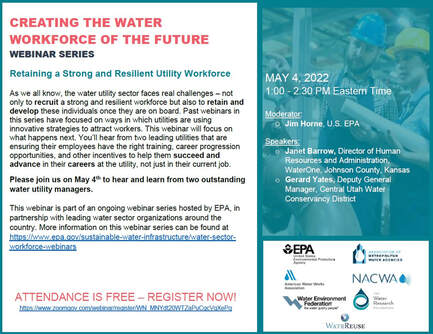
Retaining a Strong and Resilient Utility Workforce
May 4, 2022 from 1:00-2:30 PM ET.
This is part of an ongoing series of webinars to provide information across the water sector on ways utilities and others are addressing the challenges of building and maintaining a sustainable water workforce for the future. A link to these webinars can be found here. The May webinar will focus on the most fundamental part of every utility’s program - how to retain and develop a strong and resilient workforce. The two leading utilities will present on their approaches to ensuring their employees have the right training, career progression opportunities, and other incentives to help them succeed and advance in their careers.
WaterOne and Central Utah Water Conservancy District are highlighted in our recently released Compendium of Water Utility Workforce Case Studies.
Please join us on May 4th from 1:00 - 2:30 PM ET (8:00am - 9:30pm HST)
Registration is easy and free
To register, click the button below
PDHs will be available for those who attend the webinar.
May 4, 2022 from 1:00-2:30 PM ET.
This is part of an ongoing series of webinars to provide information across the water sector on ways utilities and others are addressing the challenges of building and maintaining a sustainable water workforce for the future. A link to these webinars can be found here. The May webinar will focus on the most fundamental part of every utility’s program - how to retain and develop a strong and resilient workforce. The two leading utilities will present on their approaches to ensuring their employees have the right training, career progression opportunities, and other incentives to help them succeed and advance in their careers.
WaterOne and Central Utah Water Conservancy District are highlighted in our recently released Compendium of Water Utility Workforce Case Studies.
Please join us on May 4th from 1:00 - 2:30 PM ET (8:00am - 9:30pm HST)
Registration is easy and free
To register, click the button below
PDHs will be available for those who attend the webinar.
EPA Releases Final Strategic Plan to Protect Public Health, Address Climate Change, and Advance Environmental Justice and EquityWASHINGTON (March 28, 2022) – Today, the Environmental Protection Agency published its final Fiscal Year (FY) 2022-2026 EPA Strategic Plan to accompany EPA's FY 2023 President’s Budget. The Strategic Plan provides a roadmap to achieve EPA’s and the Biden-Harris Administration’s environmental priorities over the next four years.
This Strategic Plan furthers the agency's commitment to protecting human health and the environment for all people, with an emphasis on historically overburdened and underserved communities. For the first time, EPA’s final Plan includes a strategic goal focused exclusively on addressing climate change, as well as an unprecedented strategic goal to advance environmental justice and civil rights. At the foundation of the Plan is a renewed commitment to the three principles articulated by EPA’s first Administrator, William Ruckelshaus — follow the science, follow the law, and be transparent – while adding an additional fourth principle: advance justice and equity.
“This final strategic plan is the result of tireless work across EPA to develop a comprehensive strategy that delivers on our mission to protect all people from pollution,” said EPA Administrator Michael S. Regan. “I’m confident that our plan meets the moment. Our solutions are designed to confront the challenges in front of us, where achieving justice and equity are central to addressing climate change and environmental protection.”
The Strategic Plan outlines seven goals and four cross-agency strategies. The strategies articulate essential ways of working to accomplish EPA’s goals and mission outcomes. The Plan also includes a suite of measures that will help the Agency monitor progress and ensure accountability for achieving its priorities to protect human health and the environment for all Americans.
More information on EPA’s Strategic Plans can be found at: Strategic Plan.
This Strategic Plan furthers the agency's commitment to protecting human health and the environment for all people, with an emphasis on historically overburdened and underserved communities. For the first time, EPA’s final Plan includes a strategic goal focused exclusively on addressing climate change, as well as an unprecedented strategic goal to advance environmental justice and civil rights. At the foundation of the Plan is a renewed commitment to the three principles articulated by EPA’s first Administrator, William Ruckelshaus — follow the science, follow the law, and be transparent – while adding an additional fourth principle: advance justice and equity.
“This final strategic plan is the result of tireless work across EPA to develop a comprehensive strategy that delivers on our mission to protect all people from pollution,” said EPA Administrator Michael S. Regan. “I’m confident that our plan meets the moment. Our solutions are designed to confront the challenges in front of us, where achieving justice and equity are central to addressing climate change and environmental protection.”
The Strategic Plan outlines seven goals and four cross-agency strategies. The strategies articulate essential ways of working to accomplish EPA’s goals and mission outcomes. The Plan also includes a suite of measures that will help the Agency monitor progress and ensure accountability for achieving its priorities to protect human health and the environment for all Americans.
More information on EPA’s Strategic Plans can be found at: Strategic Plan.
Statement by EPA Administrator Regan on the President’s Fiscal Year 2023 Budget
The President’s Fiscal Year 2023 budget requests $11.881 billion for the Environmental Protection Agency (EPA)’s essential work to protect people from pollution.
WASHINGTON (March 28, 2022) –The Biden-Harris Administration today submitted to Congress the President’s Budget for fiscal year 2023. The President’s Budget details his vision to expand on the historic progress our country has made over the last year and deliver the agenda he laid out in his State of the Union address—to build a better America, reduce the deficit, reduce costs for families, and grow the economy from the bottom up and middle out.
The Budget makes historic investments to advance key priorities in the FY 2022-2026 EPA Strategic Plan, including tackling the climate crisis, advancing environmental justice, protecting air quality, upgrading the Nation’s aging water infrastructure, and rebuilding core functions at the Agency.
“The President’s budget request for EPA reflects this Administration’s unwavering commitment to protect people from pollution, especially those living in overburdened and underserved communities across America. It funds a broad suite of transformational programs enacted by the Bipartisan Infrastructure Law, and it will enable us to implement the President’s historic Justice40 commitment, among other key priorities,” said EPA Administrator Michael S. Regan. “Almost half of the Budget announced today, $5.7 billion, will support Tribes, states, and localities, reaffirming EPA’s commitment to work in concert with our partners and local communities to tackle the climate crisis and ensure that no American family has to worry about the air they breathe, the water they drink, or the environmental safety of their homes and workplaces.”
The Budget makes critical investments in the American people that will help lay a stronger foundation for shared growth and prosperity for generations to come. At the EPA, the Budget invests in:
For more information on the President’s FY 2023 Budget, please visit: President’s Budget.
The President’s Fiscal Year 2023 budget requests $11.881 billion for the Environmental Protection Agency (EPA)’s essential work to protect people from pollution.
WASHINGTON (March 28, 2022) –The Biden-Harris Administration today submitted to Congress the President’s Budget for fiscal year 2023. The President’s Budget details his vision to expand on the historic progress our country has made over the last year and deliver the agenda he laid out in his State of the Union address—to build a better America, reduce the deficit, reduce costs for families, and grow the economy from the bottom up and middle out.
The Budget makes historic investments to advance key priorities in the FY 2022-2026 EPA Strategic Plan, including tackling the climate crisis, advancing environmental justice, protecting air quality, upgrading the Nation’s aging water infrastructure, and rebuilding core functions at the Agency.
“The President’s budget request for EPA reflects this Administration’s unwavering commitment to protect people from pollution, especially those living in overburdened and underserved communities across America. It funds a broad suite of transformational programs enacted by the Bipartisan Infrastructure Law, and it will enable us to implement the President’s historic Justice40 commitment, among other key priorities,” said EPA Administrator Michael S. Regan. “Almost half of the Budget announced today, $5.7 billion, will support Tribes, states, and localities, reaffirming EPA’s commitment to work in concert with our partners and local communities to tackle the climate crisis and ensure that no American family has to worry about the air they breathe, the water they drink, or the environmental safety of their homes and workplaces.”
The Budget makes critical investments in the American people that will help lay a stronger foundation for shared growth and prosperity for generations to come. At the EPA, the Budget invests in:
- Upgrading Drinking Water and Wastewater Infrastructure Nationwide. The Budget provides approximately $4 billion to advance efforts to upgrade drinking water and wastewater infrastructure nationwide, with a focus on underserved communities. The Budget funds 20 new targeted water grant programs authorized in the Drinking Water and Wastewater Infrastructure Act (DWWIA). In total, more than $940 million in new resources are provided to implement DWWIA in FY 2023. The Budget also supports water infrastructure with an increase of $160 million in grants to reduce lead in drinking water and an increase of $240 million for the Sewer Overflow and Stormwater Reuse grant program. The Budget proposes a new $25 million water sector cybersecurity grant program. The Budget also maintains funding for the State Revolving Funds, which will complement the $23.4 billion provided for the traditional SRF programs over five years in the recently enacted Infrastructure Investment and Jobs Act.
- Ensuring Clean and Healthy Air for All Communities. The Budget allocates $1.1 billion to improve air quality and reduce localized pollution, reduce exposure to radiation, and improve indoor air for communities across the country. This includes $152 million to support the development and implementation of national emission standards to reduce air pollution from vehicles, engines and fuels. The Budget also supports $299 million to assist air pollution control agencies in the development, implementation, and evaluation of programs for the National Ambient Air Quality Standards (NAAQS) and to establish standards for reducing air toxics.
- Tackling the Climate Crisis. The Budget prioritizes funding for tackling the climate crisis and invests an additional $100 million in grants to Tribes and states that will support on-the-ground efforts to reduce greenhouse gas emissions and increase resiliency in the Nation’s infrastructure. The Budget proposes an additional $35 million to implement the American Innovation in Manufacturing Act to continue phasing out potent greenhouse gases known as hydrofluorocarbons and invests an additional $13 million in wildfire prevention and readiness.
- Advancing Environmental Justice. The Administration is committed to increasing efforts to deliver environmental justice in communities across the Nation. The Budget supports the President’s Justice40 commitment to ensure at least 40 percent of the benefits of federal investments in climate and clean energy reach historically overburdened and underserved communities. The Budget invests more than $1.45 billion across the Agency’s programs that will help create good-paying jobs, clean up pollution, advance racial equity, and secure environmental justice for all communities. To elevate environmental justice as a top Agency priority, EPA has proposed a new national environmental justice program office, to coordinate and maximize the benefits of the Agency’s programs and activities for underserved communities.
- Protecting Communities from Hazardous Waste and Environmental Damage. Preventing and cleaning up environmental damage that harms communities and poses a risk to public health and safety continues to be a top priority for the Administration. The Budget provides $1.15 billion for EPA’s Superfund programs to continue cleaning up some of the Nation’s most contaminated land and respond to environmental emergencies. The Budget also includes $215 million for EPA’s Brownfields programs to provide technical assistance and grants to communities, including overburdened and underserved communities, so they can safely clean up and reuse once contaminated properties. The Budget supports additional Community Development Specialists to manage land revitalization projects and works with Tribal, rural, and overburdened and underserved communities to address brownfields.
- Strengthening Our Commitment and Ability to Successfully Implement Toxic Substances and Control Act (TSCA). The Budget provides $124 million and 449 FTE for TSCA efforts to deliver on the promises made to the American people by the bipartisan Lautenberg Act. These resources will support EPA-initiated chemical risk evaluations and protective regulations in accordance with statutory timelines.
- Tackling Per- and Polyfluoroalkyl Substances (PFAS) Pollution. PFAS are a group of man-made chemicals that threaten the health and safety of communities across the Nation. As part of the President’s commitment to tackling PFAS pollution, the Budget provides approximately $126 million in FY 2023 for EPA to increase its understanding of human health and ecological effects of PFAS, restrict uses to prevent PFAS from entering the air, land, and water, and remediate PFAS that have been released into the environment. EPA will continue to act on the Agency’s PFAS Strategic Roadmap to safeguard communities from PFAS contamination.
- Enforcing and Assuring Compliance with the Nation’s Environmental Laws. The Budget provides $213 million for civil enforcement efforts, which includes increasing enforcement efforts in communities with high pollution exposure and to prevent the illegal importations and use of hydrofluorocarbons in the U. S. The Budget also includes $7 million to operate a coal combustion residuals compliance program, $148 million for compliance monitoring efforts, and $69 million for criminal enforcement efforts, including the development of a specialized criminal enforcement task force to address environmental justice issues in partnership with the Department of Justice.
- Restoring Critical Capacity to Carry Out EPA’s Core Mission. The Budget includes more than 1,900 new Full Time Equivalents (FTEs) relative to current levels, for a total of more than 16,200 FTEs, to help rebuild the Agency’s capacity. Restoring staffing capacity across the Agency will facilitate and expedite EPA’s work to reduce air, water, and climate pollution and advance environmental justice. The Budget continues to strengthen the Agency’s ability to recruit, hire, develop, promote, and retain top talent and remove barriers to equal opportunity at the management and staff levels in order to strengthen and advance diversity, equity, inclusion, and accessibility.
For more information on the President’s FY 2023 Budget, please visit: President’s Budget.
Statement from EPA Administrator Regan on the Department of Defense’s Announcement to Defuel and Close the Red Hill Bulk Fuel Storage Facility
WASHINGTON (March 7, 2022) – EPA Administrator Michael S. Regan issued the following statement after the Department of Defense announced it will defuel and permanently close the Red Hill Bulk Fuel Storage Facility on Oʻahu, Hawaii.
“I welcome this announcement from Secretary Austin and thank him for his leadership,” said Administrator Regan. “EPA is committed to working collaboratively with our state and federal partners to ensure clean drinking water for the people of Oʻahu. As the Department of Defense moves forward with the defueling and closure of the Red Hill Bulk Fuel Storage Facility, EPA will continue to provide assistance and oversight. We will also work with the Department of Defense to make sure the public understands and has confidence in the process, knowing that EPA will remain involved.”
In recent weeks, Administrator Regan, Deputy Administrator Janet McCabe, and Regional Administrator for the Pacific Southwest Martha Guzman have all visited Oʻahu and the Red Hill facility to see firsthand the drinking water response activities, engage with the impacted community, and meet with local, state, and federal partners.
EPA has been on the ground with an emergency response team since the earliest days of the drinking water response at Joint Base Pearl Harbor-Hickam (JBPHH) and the adjacent Aliamanu Military Reservation and Red Hill Housing Army Complex. The agency will continue to partner with the Navy, Army, and the Hawaii Department of Health in the Interagency Drinking Water System Team (IDWST), which is working to restore safe drinking water to the affected residents and workers. As part of EPA’s ongoing regulatory and oversight responsibilities, EPA will continue with its underground storage tank investigation and Spill Prevention, Control, and Countermeasure (SPCC) and Facility Response Plan (FRP) investigation at Joint Base Pearl Harbor-Hickam to assess compliance with regulations governing underground storage tanks, aboveground tanks, and associated fuel transfer piping. EPA will also oversee operations related to the newly announced defueling operation to ensure that it is conducted in an environmentally sound manner.
For more information on EPA’s role in the drinking water response at JBPHH, please visit: https://www.epa.gov/red-hill/drinking-water-emergency-joint-base-pearl-harbor-hickam-honolulu-hawaii.
For Secretary of Defense Lloyd J. Austin III’s statement on the closure of the Red Hill Bulk Fuel Storage Facility please visit: https://www.defense.gov/News/Releases/Release/Article/2957825/statement-by-secretary-of-defense-lloyd-j-austin-iii-on-the-closure-of-the-red/.
WASHINGTON (March 7, 2022) – EPA Administrator Michael S. Regan issued the following statement after the Department of Defense announced it will defuel and permanently close the Red Hill Bulk Fuel Storage Facility on Oʻahu, Hawaii.
“I welcome this announcement from Secretary Austin and thank him for his leadership,” said Administrator Regan. “EPA is committed to working collaboratively with our state and federal partners to ensure clean drinking water for the people of Oʻahu. As the Department of Defense moves forward with the defueling and closure of the Red Hill Bulk Fuel Storage Facility, EPA will continue to provide assistance and oversight. We will also work with the Department of Defense to make sure the public understands and has confidence in the process, knowing that EPA will remain involved.”
In recent weeks, Administrator Regan, Deputy Administrator Janet McCabe, and Regional Administrator for the Pacific Southwest Martha Guzman have all visited Oʻahu and the Red Hill facility to see firsthand the drinking water response activities, engage with the impacted community, and meet with local, state, and federal partners.
EPA has been on the ground with an emergency response team since the earliest days of the drinking water response at Joint Base Pearl Harbor-Hickam (JBPHH) and the adjacent Aliamanu Military Reservation and Red Hill Housing Army Complex. The agency will continue to partner with the Navy, Army, and the Hawaii Department of Health in the Interagency Drinking Water System Team (IDWST), which is working to restore safe drinking water to the affected residents and workers. As part of EPA’s ongoing regulatory and oversight responsibilities, EPA will continue with its underground storage tank investigation and Spill Prevention, Control, and Countermeasure (SPCC) and Facility Response Plan (FRP) investigation at Joint Base Pearl Harbor-Hickam to assess compliance with regulations governing underground storage tanks, aboveground tanks, and associated fuel transfer piping. EPA will also oversee operations related to the newly announced defueling operation to ensure that it is conducted in an environmentally sound manner.
For more information on EPA’s role in the drinking water response at JBPHH, please visit: https://www.epa.gov/red-hill/drinking-water-emergency-joint-base-pearl-harbor-hickam-honolulu-hawaii.
For Secretary of Defense Lloyd J. Austin III’s statement on the closure of the Red Hill Bulk Fuel Storage Facility please visit: https://www.defense.gov/News/Releases/Release/Article/2957825/statement-by-secretary-of-defense-lloyd-j-austin-iii-on-the-closure-of-the-red/.
For Immediate Release: February 4, 2022
Media Contact: [email protected]
Statement by Regional Administrator Martha Guzman on the Drinking Water Emergency at Joint Base Pearl Harbor-Hickam and the Plan for EPA Inspections
SAN FRANCISCO – EPA Regional Administrator for the Pacific Southwest Martha Guzman issued the following statement today regarding EPA’s ongoing efforts to ensure a safe drinking water supply at Joint Base Pearl Harbor-Hickam and the Red Hill Bulk Fuel Storage Facility. The EPA announced its intent to conduct inspections at the facility within weeks.Statement from Regional Administrator Guzman:
EPA, an independent regulatory and executive agency, is committed to ensuring clean water for the residents of Hawaii and ensuring that the O’ahu aquifer is protected. The agency has been on the ground with an emergency response team since the earliest days following the November 2021 release and EPA Deputy Administrator Janet McCabe recently visited to see firsthand the ongoing work and engage with stakeholders. As Deputy Administrator McCabe has conveyed, EPA will continue to work diligently and leverage its authorities to ensure a safe drinking water supply.
As co-regulators with the Hawaii Department of Health, under the 2015 Joint Administrative Order on Consent (AOC), EPA has been engaged in a longstanding partnership with the state to require actions from Navy to take steps to ensure that the groundwater resource in the vicinity of the facility is protected and to ensure that the facility is operated and maintained in an environmentally protective manner, including groundwater monitoring and the completion of a comprehensive risk assessment. In connection with that ongoing work, the EPA and the Hawaii Department of Health are taking active measures in their oversight of the Navy’s groundwater monitoring to ensure the protection of the O’ahu aquifer.
Given the recent events impacting the drinking water supply, and EPA’s ongoing regulatory and oversight responsibilities related to the AOC, EPA will, within weeks, be conducting an underground storage tank inspection and a Spill Prevention, Control, and Countermeasure (SPCC) and Facility Response Plan (FRP) inspection at Joint Base Pearl Harbor-Hickam. The focus of the inspections will be to assess compliance with regulations governing underground storage tanks, aboveground tanks, and associated fuel transfer piping.
A copy of the letter notifying Navy of this action is available at: https://www.epa.gov/system/files/documents/2022-02/notice-of-inspection-at-joint-base-pearl-harbor-hickham-2022-02-04.pdf
More information about EPA’s actions with regard to Red Hill can be found at: https://www.epa.gov/red-hill
Media Contact: [email protected]
Statement by Regional Administrator Martha Guzman on the Drinking Water Emergency at Joint Base Pearl Harbor-Hickam and the Plan for EPA Inspections
SAN FRANCISCO – EPA Regional Administrator for the Pacific Southwest Martha Guzman issued the following statement today regarding EPA’s ongoing efforts to ensure a safe drinking water supply at Joint Base Pearl Harbor-Hickam and the Red Hill Bulk Fuel Storage Facility. The EPA announced its intent to conduct inspections at the facility within weeks.Statement from Regional Administrator Guzman:
EPA, an independent regulatory and executive agency, is committed to ensuring clean water for the residents of Hawaii and ensuring that the O’ahu aquifer is protected. The agency has been on the ground with an emergency response team since the earliest days following the November 2021 release and EPA Deputy Administrator Janet McCabe recently visited to see firsthand the ongoing work and engage with stakeholders. As Deputy Administrator McCabe has conveyed, EPA will continue to work diligently and leverage its authorities to ensure a safe drinking water supply.
As co-regulators with the Hawaii Department of Health, under the 2015 Joint Administrative Order on Consent (AOC), EPA has been engaged in a longstanding partnership with the state to require actions from Navy to take steps to ensure that the groundwater resource in the vicinity of the facility is protected and to ensure that the facility is operated and maintained in an environmentally protective manner, including groundwater monitoring and the completion of a comprehensive risk assessment. In connection with that ongoing work, the EPA and the Hawaii Department of Health are taking active measures in their oversight of the Navy’s groundwater monitoring to ensure the protection of the O’ahu aquifer.
Given the recent events impacting the drinking water supply, and EPA’s ongoing regulatory and oversight responsibilities related to the AOC, EPA will, within weeks, be conducting an underground storage tank inspection and a Spill Prevention, Control, and Countermeasure (SPCC) and Facility Response Plan (FRP) inspection at Joint Base Pearl Harbor-Hickam. The focus of the inspections will be to assess compliance with regulations governing underground storage tanks, aboveground tanks, and associated fuel transfer piping.
A copy of the letter notifying Navy of this action is available at: https://www.epa.gov/system/files/documents/2022-02/notice-of-inspection-at-joint-base-pearl-harbor-hickham-2022-02-04.pdf
More information about EPA’s actions with regard to Red Hill can be found at: https://www.epa.gov/red-hill
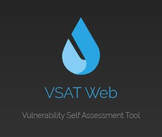
Updated EPA Products:
Conduct the Risk and Resilience Assessment
CWSs can use the Vulnerability Self-Assessment Tool Web 2.0 to conduct the risk and resilience assessment. Click on the link below to access the tool.
Access VSAT Web 2.0
Emergency Response Plan Guidance and Resource
The new template and instructions will assist water utilities with developing an Emergency Response Plan (ERP) in accordance with America’s Water Infrastructure Act of 2018 (AWIA) Section 2013(b). Click on the link below to access the tool. Access the ERP Template and Instructions
Certify the Risk and Resilience Assessment and Emergency Response Plan
CWSs can certify completion of their risk and resilience assessment and emergency response plan using U.S. EPA's online certification system. Click on the link below to learn how to certify online.
Access the Certification Resources
Other important Links:
Earthquake Resilience Products To build resilience to earthquakes at drinking water and wastewater utilities, EPA has released a suite of products, including a video, guide, and interactive maps. The Earthquake Resilience Video called “Surviving the Quake” builds awareness of earthquakes for utility risk managers and community leaders. The Earthquake Resilience Guide can help utilities better understand the earthquake threat, assess the vulnerability of utility assets, and pursue mitigation techniques and funding options. The guide draws upon the experience of actual water utilities that have successfully implemented mitigation measures to address earthquake threats. The Earthquake Interactive Maps enable utilities to determine if they are in an earthquake-prone area. Small and medium utilities, especially those that have not yet taken steps to address their seismic hazards will benefit from these products targeted to the water sector. Click here: https://www.epa.gov/waterutilityresponse/earthquake-resilience-water-and-wastewater-utilities
--
Tabletop Exercise Tool for Drinking Water and Wastewater Utilities EPA has just updated the Tabletop Exercise (TTX) Tool for drinking water and wastewater utilities. The TTX tool provides users with the resources to plan, conduct and evaluate tabletop exercises. The 2018 version of the TTX tool contains 12 customizable all-hazards scenarios (e.g., natural disasters, man-made incidents) that will assist utilities to practice, test and help improve emergency response plans and procedures.
Click here: https://www.epa.gov/waterresiliencetraining/develop-and-conduct-water-resilience-tabletop-exercise-water-utilities
--
EPA: Investing in Infrastructure Resilience Webinar Series
EPA's Water Security Division is hosting a webinar series during Critical Infrastructure Security and Resilience Month to highlight activities, technology and funding opportunities that will help drinking water and wastewater utilities increase investment in building resilience. To Register click the "Select A Date" box on this webpage to enroll in one or all of the presentations.
Conduct the Risk and Resilience Assessment
CWSs can use the Vulnerability Self-Assessment Tool Web 2.0 to conduct the risk and resilience assessment. Click on the link below to access the tool.
Access VSAT Web 2.0
Emergency Response Plan Guidance and Resource
The new template and instructions will assist water utilities with developing an Emergency Response Plan (ERP) in accordance with America’s Water Infrastructure Act of 2018 (AWIA) Section 2013(b). Click on the link below to access the tool. Access the ERP Template and Instructions
Certify the Risk and Resilience Assessment and Emergency Response Plan
CWSs can certify completion of their risk and resilience assessment and emergency response plan using U.S. EPA's online certification system. Click on the link below to learn how to certify online.
Access the Certification Resources
Other important Links:
- EPA’s AWIA main page, which contains links for all the resources listed below: https://www.epa.gov/waterresilience/americas-water-infrastructure-act-risk-assessments-and-emergency-response-plans
- EPA’s resources for completing Risk and Resilience Assessments:
- Small System Risk and Resilience Assessment Checklist·
- AWIA Frequently Asked Questions Document
- AWIA Risk Assessment and Emergency Response Plan Requirements Fact Sheet
Earthquake Resilience Products To build resilience to earthquakes at drinking water and wastewater utilities, EPA has released a suite of products, including a video, guide, and interactive maps. The Earthquake Resilience Video called “Surviving the Quake” builds awareness of earthquakes for utility risk managers and community leaders. The Earthquake Resilience Guide can help utilities better understand the earthquake threat, assess the vulnerability of utility assets, and pursue mitigation techniques and funding options. The guide draws upon the experience of actual water utilities that have successfully implemented mitigation measures to address earthquake threats. The Earthquake Interactive Maps enable utilities to determine if they are in an earthquake-prone area. Small and medium utilities, especially those that have not yet taken steps to address their seismic hazards will benefit from these products targeted to the water sector. Click here: https://www.epa.gov/waterutilityresponse/earthquake-resilience-water-and-wastewater-utilities
--
Tabletop Exercise Tool for Drinking Water and Wastewater Utilities EPA has just updated the Tabletop Exercise (TTX) Tool for drinking water and wastewater utilities. The TTX tool provides users with the resources to plan, conduct and evaluate tabletop exercises. The 2018 version of the TTX tool contains 12 customizable all-hazards scenarios (e.g., natural disasters, man-made incidents) that will assist utilities to practice, test and help improve emergency response plans and procedures.
Click here: https://www.epa.gov/waterresiliencetraining/develop-and-conduct-water-resilience-tabletop-exercise-water-utilities
--
EPA: Investing in Infrastructure Resilience Webinar Series
EPA's Water Security Division is hosting a webinar series during Critical Infrastructure Security and Resilience Month to highlight activities, technology and funding opportunities that will help drinking water and wastewater utilities increase investment in building resilience. To Register click the "Select A Date" box on this webpage to enroll in one or all of the presentations.
Click each image below to access EPA's information on each topic.
